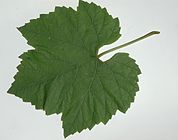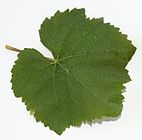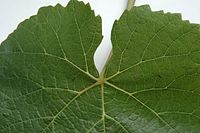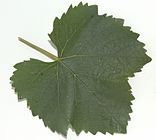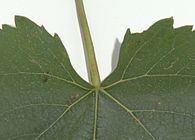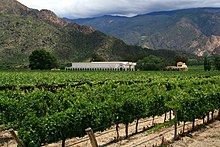Chardonnay
| Chardonnay | |
|---|---|
| Synonyms | Chardonnay Blanc - for more see the Synonyms section |

|
|
| Art | Grape vine ( Vitis vinifera subsp. Vinifera ) |
| Berry color | green-yellow to amber |
| use | |
| origin | France, Burgundy |
| known since | 1685-1690 |
| VIVC no. | 2455 |
| ancestry | |
|
Cross of |
|
| List of grape varieties | |
The white wine variety Chardonnay (French: [ ʃaʁ.dɔ.nɛ ]) is a variety that is widespread worldwide and has a high quality potential and is well known. This is not only due to their taste qualities, but also to the good adaptability of the grape variety to different site conditions. It brings appealing wine qualities to various locations around the world.
Worldwide there are around 200,000 hectares of vineyards planted with Chardonnay. This puts the variety in the ranking of the most widely grown grape varieties (2010) after Cabernet Sauvignon , Merlot , Airén and Tempranillo . The most famous Chardonnay wines grow in the French wine-growing regions of Puligny-Montrachet , Meursault , Corton-Charlemagne and Chablis . Towards the end of the last century and at the beginning of the 21st century, the variety experienced a great success story.
Descent, origin
Chardonnay is a natural cross between Gouais Blanc (= Heunisch ) and Pinot. Since the genetic differences between Pinot Blanc , Pinot Gris and Pinot Noir are small, an exact specification of the Pinot type is not yet available.
Today, Burgundy is the region of origin . There is a small community with the name " Chardonnay ", a place name derived from "Chardon" ( French thistle). The place gave its name to the variety, the name of which was determined at the 1872 wine exhibition in Lyon.
The earlier assumption that the variety was brought to France by the Crusaders and spread by the Benedictines in Burgundy is contradicted by the fact that it is demonstrably a natural cross between Pinot and the " Heunisch " variety that was already present in Burgundy at that time , acts. The DNA test results only allow Burgundy to be the place of origin.
The variety was first mentioned in 1583 under the synonym Beaunois in the Saône-et-Loire department. The specification is not certain, however, as the Aligoté variety was possibly meant. The earliest reliable mention of Chardonnay comes from 1685-1690 from the village of Saint-Sorlin, today's La Roche-Vineuse in the Saône-et-Loire department , where it was called Chardonnet.
The orders of the Benedictines and Cistercians spread the variety across Europe.
Clones
Clone selection began as early as the second half of the last century in France and later in other countries . Today a wide range of clones is available to the winemaker.
Mutations
The variety belongs to the group of Burgundy varieties and it is known that mutations occur very frequently. This also applies to crossings with Pinot.
Chardonnay Blanc Musque : A mutation of Chardonnay from France. Synonyms: Chardonnay Musque, Chaudenet, Giboudot Blanc, Griset Blanc, Plant Gris, Troyen Blanc. Has a superficial nutmeg aroma.
Chardonnay Rose : Color mutations have been found in France, Northern Italy (Veneto) and Germany (Bergstrasse). The variant found in Germany is being processed by the University of Geisenheim and is registered for plant variety protection. In 2010 a vineyard was planted. The differences between “Chardonnay” and “Chardonnay Rose” are comparable to “White Riesling” and “ Red Riesling ”.
Chardonnay Blanc Seedless : A seedless Chardonnay from Australia.
Ampelographic variety characteristics
Chardonnay is very similar to the Pinot Blanc and Auxerrois varieties . The differences can only be recognized upon closer inspection.
- The shoot tip is open. It has yellowish-green woolly hairs, with a crimson tinge. The yellow-green young leaves are initially hairy and then almost hairless.
- The medium-sized green leaves are round, mostly wholly or slightly three-lobed (almost equilateral pentagon). Only the leaves of the stinging shoots are deeply indented. The stalk bay is open in a U-shape and is bounded in 95% of cases by leaf veins (bare stalk bay). The blade is bluntly serrated. The teeth are medium-sized compared to the grape varieties. The leaf surface is slightly blistered.
Differences in the leaf, stem and grape of Chardonnay, Pinot Blanc and Auxerrois:
Leaf - Pinot Blanc
Grapes - Pinot Blanc
In 1958, Pierre Galet first described the unmistakable characteristic of the leaf tissue-free stem bay to the Chardonnay, thereby separating it from Pinot Blanc and Auxerrois as a separate variety.
- The cylindrical grape is rarely shouldered, medium-sized and has dense berries (but more loosely than Pinot Blanc ). The berries are round to slightly oval, thin-skinned with soft berry flesh and are green-yellow to amber in color. The differences to Pinot Blanc are recognizable when the grapes are ripe. Chardonnay ripens a little earlier and has loose grapes and the berry color is green-yellow to amber. Pinot Blanc usually has denser grapes and berries, which are green to yellow in color. The differences depend on the clones used.
Maturity: medium to medium late (earlier than Pinot Blanc)
properties
- Chardonnay is moderately susceptible to powdery mildew and downy mildew , but susceptible to gray mold rot (but less than pinot blanc) and phytoplasm attack . Phytoplasm infestation leads to yellowing diseases such as golden yellow yellowing (French: Flavescence dorée ) or blackwood disease .
- The disadvantage of the variety is the slight sensitivity to flowering.
- The pests and grapes are attacked by grape moths to a greater extent than other varieties .
- The vine sprouts medium early and is sensitive to late frosts, but has good resistance to winter frost.
Demands on the soil
- Thrives particularly well on chalky to chalky soils. The most famous Chardonnay wines grow on the calcareous soils of Puligny-Montrachet , Meursault , Corton-Charlemagne and Chablis .
- The success of this variety is based on the fact that it produces appealing qualities on almost every type of soil.
- The soil should have sufficient depth - the water supply is better here.
- Damp and low-lime soils are unsuitable for Chardonnay.
Demands on climate and location
- Chardonnay has a large cultivation width compared to other grape varieties.
- The variety is well adaptable to the climate and does not depend on the moderate conditions as in Burgundy .
- Good, warm locations are a prerequisite for good ripeness.
Yield
Depending on the location, the variety brings medium-sized and regular yields. Too high yields (over approx. 10,000 kg / ha) require yield regulation, otherwise the wine quality will decrease.
Wine
The wine is characterized above all by its body (high extract content). The aroma is less characteristic than that of a Riesling or Gewürztraminer and is therefore often referred to as neutral. The variety only produces the best wine quality at higher maturity. If the grapes are insufficiently ripened, the wines become thin and grassy. A good Chardonnay therefore always has a relatively high alcohol content of 13% by volume and higher. As one of the few white wines , the Chardonnay can benefit from aging in oak barrels . A good Chardonnay lives from its complexity, which only arises in special locations with lime-rich soils. Depending on the climate and terroir , very different wines can be made from the grapes.
A study by the “Australian Wine Research Institute” revealed a wide range of taste components such as aromas of raspberry, vanilla, tropical fruits, peach, tomatoes, tobacco, tea and rose petals.
Vinification / Taste: Chardonnay is made in different styles around the world. Chardonnay is fermented almost exclusively dry. The terms “classic” or “international” expansion are used differently in the literature. Superior qualities usually have plenty of alcohol and extract, they are substantial and sustainable.
- Vinification with or without malolactic fermentation.
- Maturation in small oak barrels ( barriques ): This is very common with the variety, as the wine is well suited to it and can gain in quality. However, only high-quality base wines are suitable for this. When aging in wooden barrels, the wine undergoes malolactic fermentation (not always) and becomes more supple in the process. Aged in barriques, wood aromas (vanilla, smoke) complement the primary fruit aromas. In the past, wines were often emphasized by wood. Today, the wood aromas are only used moderately due to a shorter dwell time in the barrique or less toasting and wood origins.
- Aging in steel tanks: Aging in steel tanks emphasizes the fruity notes of the variety and the acidity is more concise / mineral. Usually no malolactic fermentation takes place here, otherwise the fruity notes will be lost.
- Fruity wines, fermented in steel tanks, are used for this. Chardonnay is the most important grape variety for the production of champagne and makes up 100% of the content of the “Blanc de Blanc”.
distribution
Towards the end of the 20th century, the variety (where the melodious name was one of the decisive factors) was known worldwide and stylized as a fashion variety. Until about the mid-1990s, full-bodied, single-variety wines with spicy oak were very much in vogue. From this time onwards, the trend was towards leaner, more appealing wines with significantly less barrique notes or without wood aging. At the turn of the millennium, the expansion of the variety reached its peak. Since then, the area under cultivation has not increased - with differences in the countries.
In 2010, around 200,000 hectares of vineyards were planted with Chardonnay worldwide. This places the variety in 5th place in the ranking of the most widely grown grape varieties (2010).
Because of the great similarity with the Pinot Blanc variety , in some countries no distinction was made between Chardonnay and Pinot Blanc when recording the area of the vineyards, so that statistical figures are unreliable until the 1980s. In Italy, for example, serious surveys were not started until 1978 to determine the proportion of Chardonnay in the vineyards or to separate it from Pinot Bianco . Therefore, the Chardonnay does not appear in Italian statistics until the early 1980s. In Austria, both varieties were recorded in total up to the 1999 vineyard survey. In Germany, Chardonnay was only approved for cultivation by the Bundessortenamt in 1994 .
Worldwide acreage of the Chardonnay variety (2010)
| country | Vineyards ha |
|---|---|
| Argentina | 6473 |
| Australia | 27,773 |
| Brazil | 377 |
| Bulgaria | 2457 |
| Chile | 13,082 |
| China | 738 |
| Germany (2015) | 1764 |
| France | 45.243 |
| Greece | 586 |
| Israel | 142 |
| Italy | 19,709 |
| Japan | 602 |
| Canada | 1178 |
| Croatia | 668 |
| Luxembourg | 16 |
| Moldova | 5134 |
| Myanmar | 1 |
| New Zealand | 3911 |
| Austria (2015) | 1576 |
| Peru | 1 |
| Portugal | 803 |
| Romania | 1067 |
| Russia | 1981 |
| Slovakia | 310 |
| Slovenia | 1208 |
| South Africa | 8278 |
| Spain | 6958 |
| Switzerland (2015) | 358 |
| Czech Republic | 766 |
| Turkey | 142 |
| Hungary | 2757 |
| Ukraine | 2985 |
| Uruguay | 149 |
| United Kingdom | 235 |
| United States | 40,846 |
| Cyprus | 128 |
| World acreage 2010 | 199,632 |
France
In France , 45,243 hectares are planted with Chardonnay (as of 2010). In 1958 it was only 7,325 ha.
The Burgundian white wines from Chablis , Meursault or Puligny-Montrachet are pure Chardonnay wines. In the Champagne Chardonnay is an average of 30%, in Blanc de Blancs- -Champagne 100%. The variety is mainly cultivated in Burgundy and Champagne . It is the second most popular white wine variety in France after Ugni Blanc .
Burgundy
Chardonnay is one of the dominant varieties of Burgundy, although the vines cultivated only about one third of the Pinot Noir corresponds (Pinot Noir). In addition to the Chablis, it is mainly grown on the Côte d'Or - mainly on the Côte de Beaune - as well as on the Côte Chalonnaise and in the Mâconnais.
The grape variety achieves the highest quality in the eight Grand Cru locations of the Côte d'Or, in which it is approved for cultivation. In addition to the Le Montrachet, Criots-Bâtard-Montrachet, Bâtard-Montrachet, Chevalier-Montrachet and Bienvenue-Bâtard-Montrachet locations, it is also grown in the top locations Charlemagne, Corton-Charlemagne and Le Musigny. The white wines from these locations are among the most renowned, most expensive and exclusive in the world and have long been considered a role model for many winemakers in the New World. The wines usually have a higher alcohol content than in the other regions of Burgundy, which is often over 13 % by volume , and convince with an abundance of aromas. The wines of the Grand Cru sites need several years of bottle storage to develop the typical bouquet .
South of the Côte d'Or are the wine-growing regions of the Côte Chalonnaise and the Mâconnais. The most important wine-growing communities on the Côte Chalonnaise are Mercurey , Montagny-lès-Buxy and Rully . The best producers achieve qualities there that are only slightly inferior to those of the Côte de Beaune. The most important wine-growing communities of the Mâconnais are not far from the city of Mâcon . The most important appellation of this region is the internationally known designation of origin Pouilly-Fuissé . The vines grow there at the foot of the rocky cliffs of Solutré and Vergisson, which mark the end of a limestone plateau on which all Burgundies grow, with the exception of Beaujolais . Pouilly-Fuissé wines have long been a huge hit in the United States. The resulting shortage led to a price level that approached that of the Grand Cru wines of the Côte d'Or. Simple Mâcon wines should be drunk within 2–3 years after the harvest, otherwise they will lose their fruity, fresh character. This type of wine was considered by the large mass producers in South Africa, Argentina and California as a model for their own products.
chablis
The Chardonnay is the only approved grape variety of the single-variety Chablis. The name was particularly well known in the 1970s and 1980s and was a synonym for a dry white wine at that time. Before the introduction of trademark protection for the name Chablis , Australian and Californian winemakers in particular used this name on the bottle label in order to market their dry white wines even from other grape varieties with the catchy name.
The Chablis wine region, with the status of a protected designation of origin , is located on the edge of the Paris basin . The soils of the geological age Kimmeridgian are exposed at this point due to faults . In the limestone of the Kimmeridgian there are numerous inclusions of petrified shells.
The highest quality is produced in the seven Grand Cru locations of the Chablis. The locations Blanchots, Bougros, Les Clos, Grenouilles, Preuses, Valmur and Vaudésir are not far from the town of Chablis on a hillside above the river Serein . A special feature of these locations, which are favored by the type of soil and the microclimate, is the formation of the “goût de pierre à fusil”, an aroma of flint .
Another characteristic of the wine-growing region is its northern location with a cool wine-growing climate. This climate gives the Chardonnay a pronounced acidity , which the winemaker usually leaves in favor of the fruitiness in the wine. The wines are therefore usually matured in stainless steel tanks and do not go through malolactic fermentation . The steely acidity, which is largely determined by the comparatively high proportion of malic acid , is one of the trademarks of the Chablis and gives the white wine a good longevity.
Champagne
The vineyards of Champagne lie between 48 ° and 49.5 ° north latitude on the northern border of French viticulture. The climate is semi-continental with oceanic influences. In the Champagne growing region , Chardonnay is one of the three important grape varieties alongside Pinot Noir and Pinot Meunier . Most of the vineyard is located in the department of Aube and Marne . Together with the nearby Chablis, almost half of the Chardonnay cultivated area in France is here.
The limestone soils of the Côte des Blancs along the Marne are particularly suitable for growing this variety. The Belemnit - chalk from the Upper Cretaceous is found in the heart of the growing area between the Montagne de Reims and the Côte des Blancs. The soil stores moisture very well, but drains excess water downwards just as well. The most important wine-growing communities on the Côte des Blancs are Avize , Cramant and Le Mesnil-sur-Oger . While the vineyards in Avize produce comparatively light wines, the most aromatic base wines of the Côte des Blancs come from Cramant . In Le Mesnil-sur-Oger, the acidity is usually higher than in the surrounding communities. Most of the Blanc de Blancs champagnes , i.e. sparkling wines made exclusively from white grapes, are also produced in this region. The base wines from Chardonnay bring finesse to the cuvee, provided that Pinot Noir and / or Pinot Meunier berries are used.
Other regions of France
In addition to the region in northern France already mentioned, the Languedoc wine-growing region has the largest Chardonnay stocks. Originally the Chardonnay was grown almost exclusively in the area around the city of Limoux . Together with the leading variety Mauzac , the variety is an important component of the sparkling wine Blanquette de Limoux . The same applies to the Crémant de Limoux .
Meanwhile, a significant part of the variety grown on more than 9000 hectares is in the popular Vin de Pays d'Oc. The aim in creating this country wine was to be able to produce single-variety wines of internationally known grape varieties in sufficiently large quantities.
In the Jura growing region , Chardonnay is used in the appellations Arbois , Côtes du Jura and L'Étoile as well as in the sparkling wine Crémant du Jura . In the Jura, which is at the same geographic altitude as Burgundy, the Chardonnay is often blended with the Savagnin .
United States of America
California is the second largest Chardonnay growing area. 40,846 hectares of vineyards are planted with this grape variety. Almost half of California's holdings are concentrated in Sonoma , Napa and Monterey Counties . In addition to California, the states of Oregon and Washington also play a role.
California
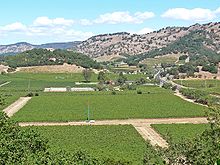
The first signs of successful cultivation of Chardonnay in California came from a region that today corresponds to the Livermore Valley AVA designation of origin . The Wente Vineyards winery had the merit of selecting a clone suitable for the climatic conditions of the region. The clone (called clone 4 or Wente clone), which was bred by Ernest Wente, has been used successfully since the 1940s.
Former American Ambassador to Rome, James D. Zellerbach, acquired around 80 hectares of land in the Mayacamas Mountains in 1948 . Zellerbach's goal was to develop Pinot Noir and Chardonnay based on the model of great Burgundy wines. In 1953 he planted his first vineyard of just 1.5 hectares and named his winery Hanzell Winery . The wines marketed since 1957 had great success. Other winemakers in the region emulated Zellerbach and also planted the Burgundy varieties. The Chardonnay wines of California gained international recognition in a legendary wine tasting in 1976, which became known as the Paris Wine Jury . In this blind tasting with a jury composed primarily of Americans and French, the white wines of the top-class Burgundy and Chablis were compared with the best producers in California. The winner was a wine from the Californian vineyard Château Montelena . With the verdict of the Paris wine jury, the hitherto unquestioned supremacy of French quality wines was publicly questioned for the first time. As a consequence, the demand for California wine increased dramatically. As early as 1988, California was on par with France in terms of the area under vines. With almost 44,500 hectares in 2007, the American state represents a quarter of the world's Chardonnay stock.
While at first the aim of the leading winemakers was to achieve a Burgundy style, an independent Californian wine style quickly developed. The climate enables a reliable achievement of full maturity. The resulting aromas and the higher must weight create full-bodied wines that allow aging in small oak barrels. In recent years the trend has been away from very high alcohol levels. With the use of new technologies such as reverse osmosis and the spinning cone (English Spinning Cone Column ) some wine houses try to get excess alcohol from the wine and limit the alcohol content of 12.5 to 14 vol .-%. The technologies mentioned are very expensive.
The designations of origin (called American Viticultural Area or AVA for short) in the Alexander Valley , Los Carneros , Santa Maria Valley , Russian River Valley and parts of Sonoma County have stood out as wine-growing regions with high quality potential . What these wine-growing regions have in common is that they benefit from the cooling effect of the morning mist of the nearby Pacific . This lengthens the ripening process and enables the berries to produce more extract.
In the long valley of California there are huge vineyards whose grapes are used to produce inexpensive bulk wines . With an early harvest, berries that are suitable for producing good quality sparkling wines can also be picked in the cooler locations of California. Leading champagne houses such as Bollinger , Louis Roederer , Moët & Chandon or Taittinger have their own wineries or significant holdings in the region.
Other American states
The climate of the state of Washington, which is further north compared to California (→ viticulture in Washington ) favors mostly fruity white wines. Since the year 2000 at the latest, Chardonnay has been the most important quality grape variety in Washington in terms of area. The winemakers use vine material that was selected by the University of Davis. In contrast to the classic clones of Burgundy, Davis relies on clones that mature a little later. The longer ripening time increases the aroma yield of the vine and ensures that the grape material retains sufficient acidity.
The Chardonnay wines from Washington have a well-developed apple aroma, which in American literature is similar to the apple varieties Golden Delicious , Fuji , Gala or Jonathan .
In Oregon's cooler climate , winemakers use the precocious clones of Burgundy because of the shorter growing season.
Australia
Chardonnay is grown very successfully in Australia - there were 27,773 hectares in 2010. The grape variety was introduced in 1832 by James Busby. The Hunter Valley, besides Shiraz, also cultivates Chardonnay.
Italy
In Italy , 19,709 hectares were planted with Chardonnay in 2010. The largest stocks are in the growing areas of Friuli , South Tyrol (Alto Adige), Trentino and Veneto . The cultivation of Chardonnay has a long tradition, especially near the Alps, but was not noticed until the late 1970s. Until the 1980s, however, these wines were known as Pinot Bianco . Large stocks stood together in a mixed set. Since one of the distinguishing features is the berry color when fully ripe, both the Pinot Blanc and the Yellow Pinot Blanc , which is actually the Chardonnay, were known in South Tyrol . In 1982, not a single hectare of Chardonnay was mentioned in an official agricultural survey. In 1990, however, 6,000 ha were identified.
The grape variety is still widely used today in a blend with different varieties such as Albana , Catarratto Bianco comune , Catarratto Bianco lucido , Cortese , Erbaluce , Favorita , Garganega , Grecanico Dorato , Nuragus , Procanico , Ribolla Gialla , Verdeca , Vermentino and Viognier .
Chile
The acreage in Chile was 13,082 ha in 2010.
South Africa
The acreage in South Africa was 8,278 ha in 2010.
Argentina
Argentina had 6,473 hectares of Chardonnay in 2010, mainly in the Mendoza area .
Moldova
The area under cultivation in the Republic of Moldova was 5134 hectares in 2010. During the time when Moldova was still part of the Soviet Republic, the majority of the wine harvest was used to produce sparkling wine. Single-variety Chardonnay wines are now also produced.
New Zealand

The New Zealand Chardonnays have more natural acidity than the wines from Australia. In 2011 the area under vines was 3,938 hectares, with a hardly rising trend. In 2007 the area under vines was 3,802 hectares.
Austria
In the southern Styria wine-growing region, the Chardonnay is also called "Morillon". In 2015, 1576 hectares were planted with Chardonnay in Austria , which corresponds to 5.2% of the white wine growing area. That is the 6th place after the Grüner Veltliner (47.1%), Welschriesling (10.1%), Riesling (6.6%), Pinot Blanc (6.3%) and Müller-Thurgau (5.8%) ).
| Growing area | Area in ha |
| Austria | 1,576 |
|
603.6 |
|
599.8 |
|
316.8 |
|
40.2 |
|
16.2 |
Germany
In Germany, 1,764 hectares (= 1.7% of the German vineyard area) were planted with the Chardonnay grape variety - in 2006 there were 1087 hectares and in 1999 only 531 hectares. The grape variety has been approved by the Bundessortenamt since 1994 .
| Growing area | Area in ha | Percentage ownership % |
| Germany | 1,764 | 1.7 |
| Rhineland-Palatinate | 1,439 | 2.2 |
|
670 | 2.8 |
|
657 | 2.5 |
|
54 | 1.3 |
|
55 | 0.6 |
|
2 | |
|
1 | |
| Baden-Württemberg | 281 | |
|
66 | |
|
217 | |
| Hesse | 20th | |
|
4th | |
|
16 | |
| Bavaria (Franconia) | 17th | |
| Saxony-Anhalt | 2 | |
| Saxony | 1 | |
| Thuringia | 1 | |
| Saarland | 2 |
Slovenia
The cultivation area in Slovenia was around 1208 ha in 2010.
Switzerland
In Switzerland, Chardonnay is mainly cultivated in the canton of Valais , Vaud and Ticino . The area under vines is 358.8 hectares (as of 2015).
Synonyms
175 synonyms for Chardonnay are known: Aligote, Arboisier, Arnaison, Arnaison Blanc, Arnoison, Aubain, Aubaine, Auvergnat Blanc, Auvernas, Auvernas Blanc, Auvernat, Auvernat Blanc, Auxeras, Auxerras Blanc, Auxerrois, Auxerrois Blanc, Auxois, Auxois Blanc , Bargeois Blanc, Bearnais, Beaunois, Biela Klevanjika, Blanc Daune, Blanc de Bonne Nature, Blanc de Champagne, Blanc de Cramant, Blanca del Pais, Bon Blanc, Breisgauer, Breisgauer Suessling, Breisgauer Sussling, Burgunder Weisser, Burgundi Feher, Chablis, Charge, d'Arnoison, d'Auvernat Blanc, d'Epintte, Dannerie, Epinette, Epinette Blanc, Epinette Blanche, Epinette de Champagne, Ericey, Ericey Blanc, Feher Chardonnay, Feherburgundi, Feinburgunder, Fin Plant Dore, Gamay B lanc, Gelber Schimber, Gelber Schimper, Gelber Weissburgunder, Gentil Blanc, Greco, Gros Blanc, Grosse Bourgogne, Gruenedel, Klawner, Kleinedel, Kleiner Heinsch, Klevanjka Biela, Klevner, Klingelberger Grosser, Short-stemmed Champagne, Luisant, Luiza, Luizannais, Luizant, Luzannois, Maconnais, Maurillon Blanc, Melan, Melier, Melon, Melon a Queue Rouge, Melon Blanc, Melon d'Arbois, Melon du Jura, Melon Gros Vert, Melon Queue de Gouri, Meunier Blanc, Moreau Blanc, Moreote Blanche, Morillon Blanc , Moulan, Moulon, Muscadet, Noiren Blanc, Noirien Blanc, Noirien Blanc Chardonnay, Obaideh, Petit Chantey, Petit Chatey, Petit Sainte-Marie, Petite Sainte Marie, Pineau Blanc, Pineau Blanc Chardonnay, Pino Plan Shardone, Pino Sardone, Pino Shardone , Pinot Bianco Chardonnay, Pinot Blanc Chardonnay, Pinot Chardonnay, Plant de Breze, Plant de Tonnerre, Plant Dore, Plant Dore Blanc, Plant Dore de Champagne, Rolaenner, Romere, Romeret, Rouci Bile, Rousseau, Roussette, Roussot, Rulander, Rulander White , Rulenner, Sainte Marie Petite, Sardone, Savignien Blanc, Shardone, Shardonne, Spaeter Weisser Burgunder, Suessling, Trappler, Veis Edler, Veiser Klevner, Vitis Aurelianensis Acinis Albis, Wais Edler, Weiss Arbs, Weiss Clevner, Weiss Cloevner, Weiss Edler, Weiss Klewner, Weiss Silber, Weissarbst, Weissarbst Rolander, Weissedler, Weisseklaevler, Weisser Burgunder, Weisser Claevner, Weisser Clevner, Weisser Klaevner, Weisser Kleinedel, Weisser Rohlaender, Weisser Rolander, Weisser Rulaender, Weisser Rulander, Weissgelber Claevner, Weissgelber Klevner, Weisser, Weissklevner.
literature
- Hans Ambrosi , Bernd HE Hill, Erika Maul, Erst H. Rühl, Joachim Schmid, Fritz Schuhmann: Color Atlas Grape Varieties , 3rd Edition, Eugen Ulmer, 2011, ISBN 978-3-8001-5957-4 .
- Karl Bauer, Ferdinand Regner , Barbara Schildberger: Viticulture. 9th, updated edition. AV book published by Cadmos Verlag, Vienna 2013, ISBN 978-3-7040-2284-4 .
- Dagmar Ehrlich : ABC of grape varieties. Vines and their wines. Hallwag, Munich 2005, ISBN 3-7742-6960-2 .
- Pierre Galet : Dictionnaire encyclopédique des cépages. Hachette Livre, Paris 2000, ISBN 2-01-236331-8 .
- Walter Hillebrand, Heinz Lott, Franz Pfaff: Paperback of the grape varieties. 13th revised edition, Fachverlag Fraund, Mainz 2003, ISBN 3-921156-53-X .
- Jens Priewe : Wine. The new big school. Zabert Sandmann, Munich 1997, ISBN 3-932023-02-1 .
- Jancis Robinson : The Oxford Wine Lexicon. 3rd completely revised edition. Hallwag, Munich 2007, ISBN 978-3-8338-0691-9 .
- Directory of the Austrian quality wine grape varieties and their clones. Higher Federal College and Federal Office for Viticulture and Fruit Growing Klosterneuburg, Klosterneuburg 2008.
Web links
Individual evidence
- ↑ a b c d e f g h i j k l K. Anderson, NR Aryal: Database of Regional, National and Global Winegrape Bearing Areas by Variety, 2000 and 2010, Wine Economics Research Center, University of Adelaide, December 2013 (first revision April 2014) (second revision May 2014) (third revision July 2014).
- ↑ Erika Maul: The very old grape variety Weißer Heunisch and their children, some of whom have become famous, such as B. Chardonnay. In: German Viticulture Yearbook. Vol. 56, 2005, ISSN 0343-3714 , pp. 129-145.
- ↑ John E. Bowers, René Siret, Carole P. Meredith, Patrice This, Jean-Michel Boursiquot: A Single Pair of Parents proposed for a Group of Grapevine Varieties in Northeastern France. In: Alain Bouquet, Jean-Michel Boursiquot (Ed.): Proceedings of the Seventh International Conference on Grapevine Genetics and Breeding. Montpellier, France, 6-10 July 1998 (= Acta Horticulturae. No. 528). International Society for Horticultural Science - Section Viticulture - Working Group on Environmental Physiology of Fruit Crops et al., Leuven et al. 2000, ISBN 90-6605-892-7 , pp. 129-132, doi: 10.17660 / ActaHortic.2000.528.15 , ( online (PDF; 19 kB) ).
- ^ Walter Schenk: Contribution to the ampelographic separation of the grape varieties Auxerrois, Chardonnay and Weißer Burgunder , Heinrich-Birk-Gesellschaft, 1986
- ↑ Hans Ambrosi , Bernd HE Hill, Erika Maul, Erst H. Rühl, Joachim Schmid, Fritz Schuhmann: Color Atlas Rebsorten 3rd Edition, Eugen Ulmer, 2011, ISBN 978-3-8001-5957-4 , p. 96.
- ^ Ferdinand Regner , Karel Hanak, Cornelia Eisenheld: Directory of Austrian quality wine grape varieties and their clones , 2nd edition 2015, HBL and BA for WB, Klosterneuburg, S25.
- ↑ a b c Jancis Robinson , Julia Harding, José Vouillamoz : Wine Grapes , 1st edition 2012, Penguin Books, London, ISBN 978-0-06-220636-7 .
- ↑ Chardonnay Blanc Musque in the database Vitis International Variety Catalog of the Institute for Grapevine Breeding Geilweilerhof (English)
- ↑ Chardonnay Rose in the database Vitis International Variety Catalog of the Institute for Grapevine Breeding Geilweilerhof (English)
- ↑ Chardonnay Blanc Seedless in the database Vitis International Variety Catalog of the Institute for Grapevine Breeding Geilweilerhof (English)
- ↑ Schenk Walter: Contribution to the ampelographic separation of the grape varieties Auxerrois, Chardonnay and Pinot Blanc , German Viticulture Yearbook 1986, Waldkircher Verlagsgesellschaft, Waldkirch im Breisgau, pp. 91-101.
- ↑ Hans Ambrosi, Erika Dettweiler-Münch, Ernst H. Rühl, Joachim Schmid and Fritz Schuhmann: color atlas grape varieties. 300 varieties and their wines. 2nd, expanded edition. Eugen Ulmer, Stuttgart 1998, ISBN 3-8001-5719-5
- ↑ Joachim Schmid, Frank Manty, Bettina Lindner: Geisenheimer Rebsorten and Klone , Geisenheimer Reports 67, 2009, ISBN 978-3-934742-56-7 .
- ↑ Chardonnay variety description - vine breeding ( Memento of the original from March 21, 2016 in the Internet Archive ) Info: The archive link was inserted automatically and has not yet been checked. Please check the original and archive link according to the instructions and then remove this notice. , Geisenheim University (PDF; 279 kB)
- ↑ Ries Rudolf, Schmid Joachim: Determine grape varieties yourself , Manuscriptum Verlagsbuchhandlung, Thomas Hoof KG, Waltrop and Leipzig 2010, ISBN 978-3-937801-58-2
- ↑ Jancis Robinson : The Oxford Wine Lexicon . 3rd edition, Hallwag, 2007, ISBN 978-3-8338-0691-9 , p. 135.
- ↑ New Zealand Winegrowers Statistical annual 2008 ( Memento from May 15, 2010 in the Internet Archive ) (PDF; 3.12 MB; English)
- ↑ New Zealand Winegrowers Statistical annual 2007 ( Memento of October 18, 2008 in the Internet Archive ) (PDF; 375 kB; English)
- ↑ a b Weingarten Baseline Survey 2015, Statistics Austria 2016
- ↑ 3. Cultivation statistics for the year 2015 Deutscher Weinbauverband (2016): 19th Special Report 2016 - Planted vineyards 2015
- ↑ 2. Cultivation statistics for 2015 State Statistical Office Rhineland-Palatinate (2016): Statistical reports - Planted vineyards 2015. Bad Ems, CI - j / 15, reference number: C1073 201500, ISSN 1430-5070 .
- ↑ Cultivation statistics for 2015 Federal Statistical Office (2016): Agriculture and Forestry, Fisheries. Agricultural land use - vineyards. Technical series 3 series 3.1.5.
- ↑ The Wine Year (PDF) ( Memento of the original from July 12, 2016 in the Internet Archive ) Info: The archive link was inserted automatically and has not yet been checked. Please check the original and archive link according to the instructions and then remove this notice. , Published by the Federal Office for Agriculture FOAG, accessed on August 5, 2016
- ↑ Chardonnay in the database Vitis International Variety Catalog of the Institute for Vine Breeding Geilweilerhof (English), accessed in August 2020


